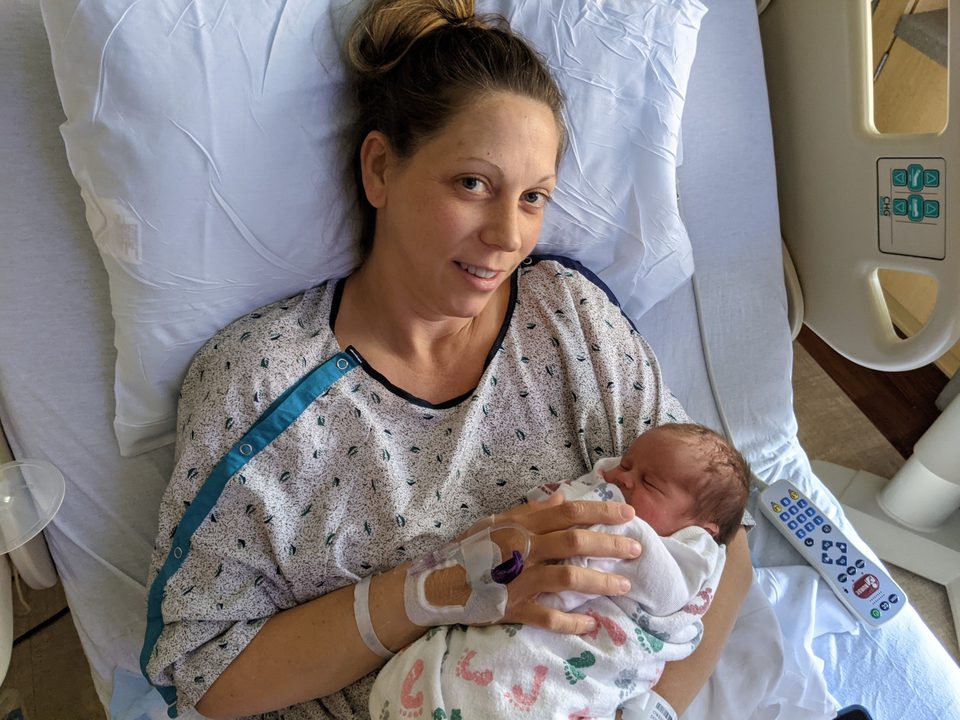Diagnosis, Planning Play Key Roles in Potentially Life-Threatening Birth

To see Tina Owens-Schmidt jogging just a couple of months after delivering her second baby, you might never know she faced a serious complication beginning in her second trimester. In fact, had she delivered 10 years ago, her condition might have resulted in a drastically different outcome.
But thanks to advances in diagnostics and careful planning on the part of her obstetrical team, both she and her baby are healthy — a credit to the research that preceded her pregnancy, as well as the clinical care it informs.
At her 20-week ultrasound appointment, Tina was diagnosed with placenta previa, meaning the placenta was lying very low in her uterus, covering all or part of the cervix. The condition is relatively common, occurring in about 1 in 200 pregnancies. During a follow-up ultrasound eight weeks later, the previa persisted; at 34 weeks, her team noticed not only the previa, but also lacunae, or lakes, in the placenta — a possible indicator for a more serious condition known as placenta accreta.
Occurring in about 1 in every 1,000 to 2,000 pregnancies, placenta accreta occurs when the placenta grows too deeply into the wall of the uterus. Instead of separating from the uterus after birth, the placenta becomes a source of uncontrolled bleeding. In some cases, it can be fatal.
“It’s a big deal. It’s life-threatening,” said Stephen Emery, MD, who works both as a clinician at UPMC Magee-Womens Hospital and a researcher with Magee-Womens Research Institute. “The right diagnosis really matters — because if you overcall it, you do an unnecessary hysterectomy. And if you undercall it, the patient can lose a lot of blood fast.”
To prevent such severe blood loss, which can be life-threatening, the clinical team may plan to deliver the baby via cesarean section and then perform a hysterectomy to remove the mother’s uterus.
In Tina’s case, at 35 weeks, she met with her Maternal-Fetal Medicine team at the hospital to discuss plans for her delivery. Though her diagnosis was not definitive, the team prepared as though she did have accreta, planning to deliver her by cesarean section and remove her uterus if necessary.
At 46, Tina was not planning additional pregnancies, so she agreed that a hysterectomy was the best option.
“Obviously, my health is very important, making sure I’m there for my kids,” she said. “The team was really informative, and I felt O.K. with it. I felt that preparedness is key in these cases.”
Such deliveries require a lot of multidisciplinary planning, including clinicians from a variety of disciplines and operating room staff, notes Arun Jeyabalan, MD, who adds that UPMC Magee-Womens Hospital is a referral center for accreta cases.
“One of the most important aspects in the scenario of some degree of uncertainty is to be prepared,” she said.
Dr. Jeyabalan said the team is always trying to improve its procedures, coordination and planning; Dr. Emery notes that additional research could improve both procedures and diagnosis, which is crucial.
Magee-Womens Research Institute collects data and specimens from placenta accreta spectrum disorders through the Steve N. Caritis Magee Obstetric Maternal & Infant Database and Biobank, which is available to researchers who are interested in the topic.
On June 21, 2021, Tina went in for her scheduled delivery.
“I remember lying on the table when they were prepping me for the C-section,” she said. Her obstetrician, Sarah Rogan, MD, explained the procedure again; Tina’s husband, Eric, came in for the Cesarian delivery of their daughter, Elaina Jane.
The team saw the accreta and immediately put Tina under general anesthesia, at which point Madeleine Courtney Brooks, MD, performed the hysterectomy as planned. Both procedures were a success.
Tina lost slightly more blood — 1.5 liters — than a normal cesarean, but because the team had planned so carefully, she got a half liter of her own blood and did not require any other transfusions.
By that evening, Tina was up and walking, and eight weeks after delivery, she was making plans for additional exercise.
“I feel very positive about my experience. I don’t think the outcome could have been better,” she said. “I needed the people who were prepared to be in that room, so their plan worked.”

Be the First to Know
Get the latest research, news, events, and more delivered to your inbox.